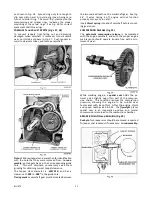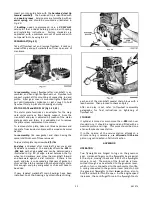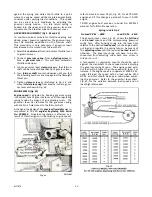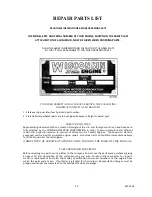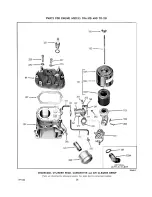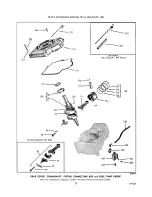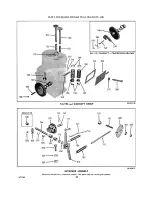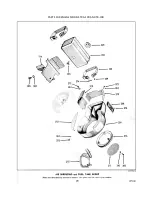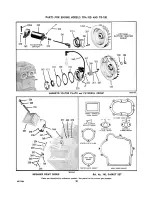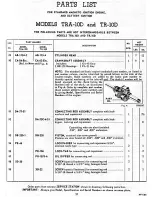
MI-1067 16
Spark plug wet or dirty.
Spark plug point gap wrong
. See Page 14.
Condensation on spark plug electrodes.
Breaker points pitted or fused.
Breaker arm sticking.
Condenser leaking or grounded.
Oil in breaker box
. See ‘Crankcase Breather’, Page 10.
Spark timing wrong
. See ‘Timing’, Page 11.
ENGINE MISSES
Spark plug gap incorrect.
See Page 14.
Worn and leaking ignition cable.
Weak spark.
See ‘Ignition Spark’, Page 10.
Loose connections at ignition wires.
Breaker points pitted or worn.
Oil in breaker box
. See ‘Crankcase Breather’, Page 10.
Water in gasoline.
Poor compression.
See ‘Compression’, Page 15.
ENGINE SURGES OR GALLOPS
Carburetor flooding.
Governor spring hooked into wrong hole in lever, or
governor rod incorrectly adjusted.
See ‘Governor Ad-
justment’, Page 24.
ENGINE STOPS
Fuel tank empty, or water, dirt or gum in gasoline.
Gasoline vaporized in fuel lines due to excessive
heat around engine (Vapor Lock)
.
See ‘Stopping En-
gine’, Page 9.
Vapor lock in fuel lines or carburetor due to using
winter gas (too volatile) in hot weather.
Air vent hole in fuel tank cap plugged. Engine scored
or stuck due to lack of oil.
Ignition troubles
.
See ‘Ignition’, Page 15.
ENGINE OVERHEATS
Crankcase oil supply low. Replenish immediately.
Ignition spark timed wrong.
See ‘Timing’, Page 11.
Low grade of gasoline, or engine overloaded.
Restricted cooling air circulation.
Part of air shroud removed from engine.
Dirt between cooling fins on cylinder head.
Engine operated in confined space where cooling air
is continually recirculated.
Dirty or incorrect grade of crankcase oil.
Restricted exhaust, or carbon in engine.
Engine operated while detonating due to low octane
gasoline or heavy load at low speed.
ENGINE KNOCKS
Poor grade of gasoline or of low octane rating.
Engine operating under heavy load at low speed.
Carbon or lead deposits in cylinder head.
Spark advanced too far.
See ‘Timing’, Page 11.
Loose or burnt out connecting rod bearing.
Engine overheated due to causes under previous
heading.
Worn or loose piston pin.
ENGINE BACKFIRES THROUGH CARBURETOR
Water or dirt in gasoline, or poor grade of gasoline.
Sticky inlet valves.
See ‘Valves and Seat Insert’,
Page 18.
Overheated valves, or hot carbon particles in engine.
Engine cold.
DISSASSEMBLY AND REASSEMBLY
OF ENGINE
Engine repairs should be made by a mechanic who
has experience in such work. When disassembling
the engine it is advisable to have several boxes avail-
able so that parts belonging to certain groups can be
kept together. Capscrews of various lengths are used
in the engine, therefore great care must be exercised
in reassembly so that right screws will be used in
the proper places.
Tighten the capscrews of the cylinder head, gear
cover, connecting rod, stator plate and the spark plug
to the specified torque readings indicated in the para-
graphs of reassembly, relative to these parts.
With the disassembling operations, instructions on
reassembling are also given, as often it will not be
necessary to disassemble the entire engine. If it is
desired to disassemble the entire engine, the re-
assembly instructions can be looked up later under
the headings of the various parts.
While the engine is partly or fully dismantled, all of
the parts should be thoroughly cleaned
.
Use all new
gaskets
in reassembly and lubricate all bearing
surfaces.
TESTING REBUILT ENGINE
An engine that has been completely overhauled; such
as having the cylinder rebored and fitted with new
piston, rings and valves, should go through a thorough
“run-in” period before any load is applied to it.
The engine should be started and allowed to run for
about one-half hour, at about 1600 to 1800 R.P.M.
without load. The R.P.M. should then be increased
to engine operating speed, still without load, for an
additional three and one-half to four hours.
The proper “running-in” of the engine will help to
establish polished bearing surfaces and proper clear-
Summary of Contents for Air Cooled TR-10D
Page 6: ...MI 937 2 4 Fig 1 289860C TAKE OFF rear and LEFT HAND SIDE VIEW of ENGINE...
Page 7: ...5 MI 938 2 FAN END front and RIGHT HAND SIDE VIEW of ENGINE...
Page 8: ...MI 939 2 6 SECTIONAL VIEWS OF ENGINE...
Page 28: ......
Page 29: ...PARTS FOR ENGINE MODELS TRA 10D AND TR 10D...
Page 30: ...PARTS FOR ENGINE MODELS TRA 10D AND TR 10D...
Page 31: ...PARTS FOR ENGINE MODELS TRA 10D AND TR 10D...
Page 32: ......
Page 33: ......
Page 34: ......
Page 35: ......
Page 36: ......
Page 37: ......
Page 38: ......
Page 39: ......
Page 40: ......
Page 44: ......
Page 46: ...WISCONSIN MOTOR CORPORATION MILWAUKEE WISCONSIN 532466 PRINTED IN U S A...





















